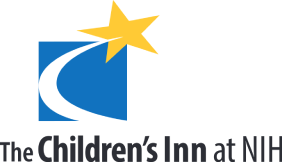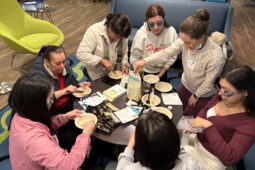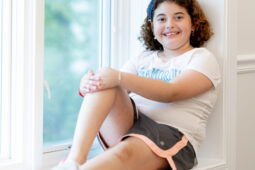A Short Visit Provides Renewal for Troy and His Family
Four-year-old Troy and his family receive care and comfort at The Inn and NIDDK while undergoing treatment for lipodystrophy.
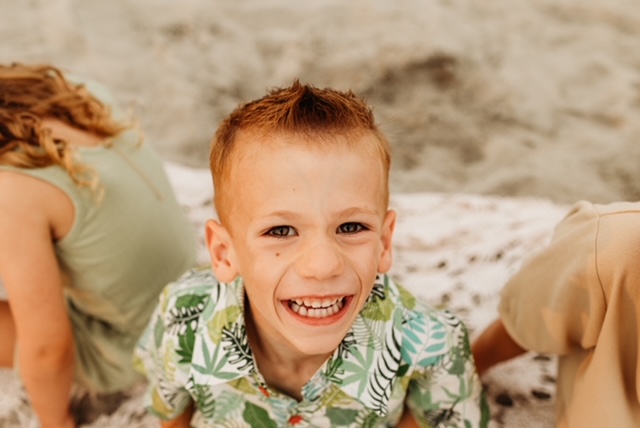
It doesn’t take long for The Children’s Inn at NIH to make an impact. Take Troy, for example, a four-year-old from Media, PA, who came to The Inn for just two days as he underwent testing and observation at the National Institute of Diabetes and Digestive and Kidney Diseases (NIDDK). During that time, he found an exciting new world to explore, and his parents, Sarah and Dan, were able to enjoy a brief respite at the end of a whirlwind year that still doesn’t feel real.
It began at his three-year-old check-up. The youngest of three boys, all under 10 years old, Troy shared his family trait of being lean. Sarah recalled how normal it was to hear that the brothers were only in the fifth percentile for weight at their regular pediatric check-ups.
“We kind of got used to that,” she explained. “But every time we go, I just ask how they’re doing. The doctors never seemed concerned with the older boys. But at [Troy’s three-year-old check-up], the doctors just looked at Troy and started to really evaluate him further.
His doctors were initially concerned that he might have muscular dystrophy, a group of genetic disorders characterized by muscle weakness. They were concerned because of his unusually prominent calf muscles, a feature which distinguished him from the rest of his family. “I just thought he was going to get a scholarship,” Sarah joked. “I thought we had this really strong, athletic kid. So that was the start of our journey. We hadn’t really had any concerns prior to that.”
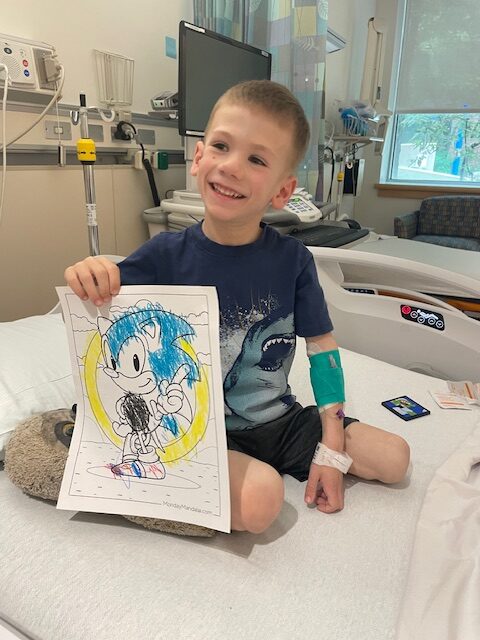
Troy during his time at the NIH Clinical Center
Troy’s pediatrician wanted him to see a neurologist. It took six months before they could get an appointment. During that time, life proceeded as normal – Troy would accompany his parents and older brothers to sporting events with his little bag of toys and snacks, watching his brothers play and running up and down the sidelines, imagining the day when he could get out there and play like his siblings. He remained a happy, affectionate child who Sarah described as both a “busybody” and a “love bug.”
When Troy finally saw the neurologist, the doctors’ concerns remained, and he was referred to a muscular neurologist. That appointment took another three months and led to a referral to the endocrinologist at CHOP. There, the denial phase came to a sudden halt with the official diagnosis of lipodystrophy.
“Each time we visited a new specialist, we held onto hope that they would say ‘oh, he’s fine. He’s just really skinny. Go home and enjoy your kid.’” Sarah recalled. “But as each doctor ruled out one thing and referred us to the next, it was clear that everyone agreed something wasn’t exactly typical.”
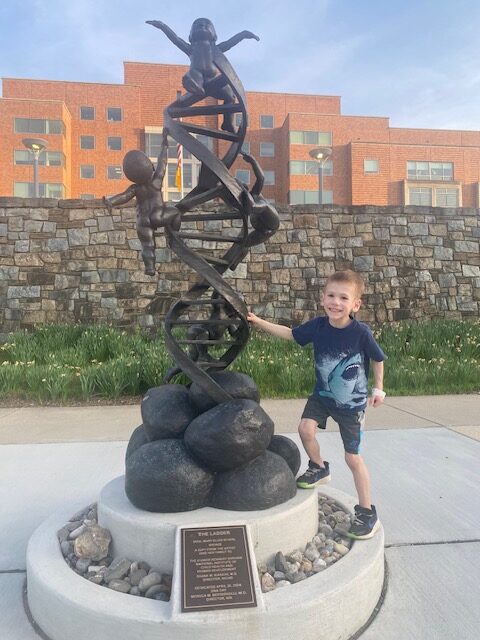
Troy loved “The Ladder,” a statue he would pass on his walk from The Inn to the Clinical Center
Generalized lipodystrophy is believed to affect only about one in one million people. While congenital generalized lipodystrophy is typically diagnosed during infancy, Troy’s case was rare even for the tiny lipodystrophy community. The endocrinologist could not yet determine whether Troy’s case was genetic or acquired, a determination that would impact the treatment options.
As she began researching the disorder, Sarah found an online community called Lipodystrophy United. There, she received words of encouragement from parents of other children with the condition, as well as lipodystrophy patients themselves. Through those interactions, she began to understand that the National Institutes of Health was the place to get the most comprehensive testing and eventual treatment. The doctors at CHOP agreed.
Troy and his parents arrived at The Children’s Inn the day before his first appointments at NIDDK. They took a walk around The Inn, and Troy instantly fell for the sunroom and the toys available there. In particular, he delighted in preparing dishes for his father from the plastic food at the toy kitchen and then spending time painting virtually at the electronic game table. For Sarah, the generosity and hospitality of The Inn washed away so much of the stress that had built up over the previous year.
“The Children’s Inn was a gift in itself,” she said after they had returned home. “The fact that Troy was able to stay in such a warm, supportive, and comfortable environment – completely free of cost – still amazes us. They made what could have been a stressful trip into something Troy actually enjoyed.”
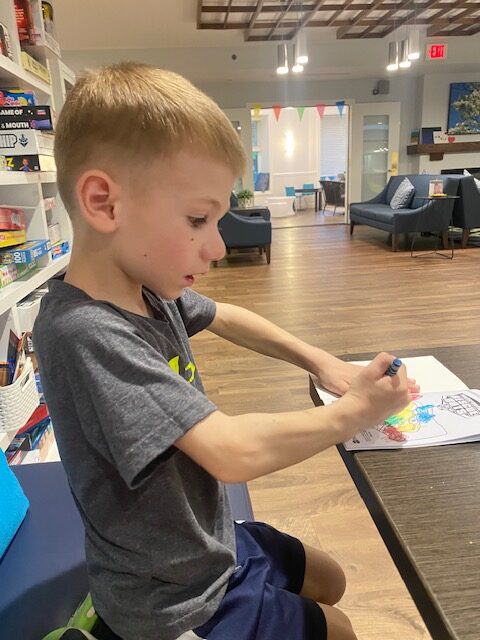
Hard at work at The Inn
Troy loved the Thoughtful Treasures that greeted him each morning at The Inn. One, a small butterfly toy, is now pinned to the window of his room at home.
A battery of tests occupied much of the rest of the trip, and the comfort that the family felt at The Inn extended to the Clinical Center. “I was amazed at how timely everything was,” Sarah said. “We even got to some tests a little early and they would go ahead and take us back. Everything was so timely and professional at the NIH, it was just such an impressive facility.”
Now back home in Media, Troy and his family still await the test results. Doctors intend to continue monitoring the boy, with annual visits to NIH expected in the future. In the meantime, Sarah has turned her attention to providing family meals that will keep Troy safe since his body doesn’t process fatty foods in a typical fashion, and fat could build up on vital organs over time.
“Megan, our scheduler [at NIDDK], was amazing,” smiled Sarah. “She had given us a heads up that a lot of parents find real value in their time with the dietician. We really looked forward to that. They gave us a lot of details about the diet and what each meal should look like and gave us some information about how to do this in a kid-friendly way. It was awesome.”
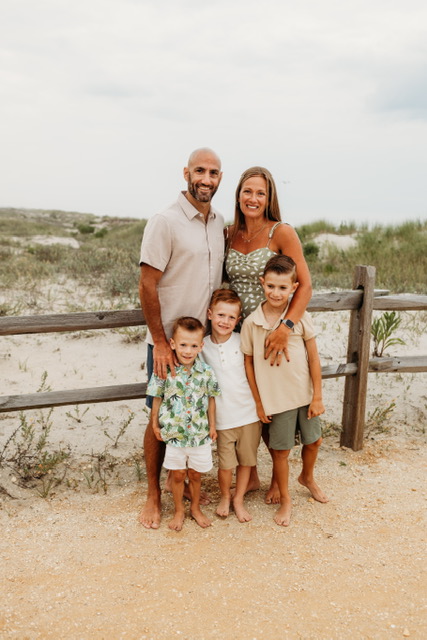
Troy (bottom left) and his family
Troy and his family are settling into their new reality. In some ways, they haven’t had time to fully shed the disbelief they were experiencing over the past year. But thanks to the calming environments at The Inn and NIDDK, they know they are in good hands.
“The time between the initial referral and the diagnosis was full of fear, uncertainty, and denial,” Sarah acknowledged. ‘But by the time we were driving home from NIH, we felt a sense of comfort and confidence in the support system we’d found and the path forward. We have such a sense of gratitude simply that places like The Children’s Inn and NIH exist, and we are so fortunate to have been able to take advantage of something like that, for as stressful and scary as those few days could have been.”
